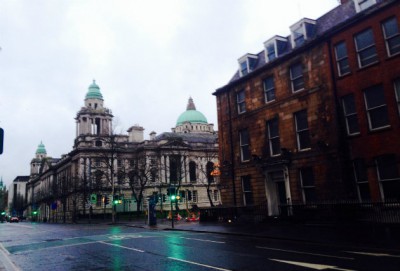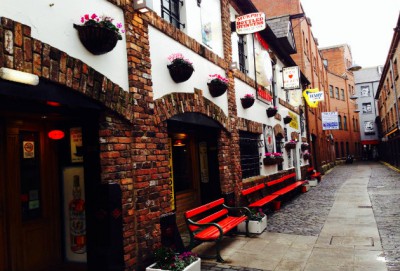BELFAST, NORTHERN IRELAND. The city of Belfast has much to offer visitors from all over the world. Unfortunately, the beauty of this city is often cast in the shadow of its political struggle and violence. Since the late 1960’s, Northern Ireland has been plagued with “The Troubles”—the term coined to describe conflict over its constitutional status. One “side” is those who want Northern Ireland to remain a part of the United Kingdom, mostly consisting of those who consider themselves British and Protestant. The other is the Irish nationalists, mostly Roman Catholic, who want to leave the UK and unite all of Ireland. The conflict is characterized by disputes between the Irish Republican Army (IRA) and the British government, full of riots, strikes, and violence. It’s assumed to have ended in the “Good Friday” Agreement of 1998 which declares Ireland will remain a part of the UK unless a majority of Northern Ireland votes otherwise.
However, political tension still exists. During my time in Belfast I stayed in the eastern part of the city, which has an entire street framed by political murals. Some depict masked IRA soldiers while others were created in memory of innocent people killed. East Belfast also holds a street dividing the Protestant and Catholic communities. This can still be the site of minor public disturbances, but I want to look past this conflict and describe what else I truly saw in Belfast.
One of the first things I noticed was the abundance of music. Throughout the city centre you can find street musicians playing classic Christmas tunes by harmonica or even mellow hit covers by guitar. In the month of September, the city hosts the Belfast Music Festival with over 100 musical events over the span of eight days. If you miss it, the beautiful Grand Opera House located on Great Victoria Street has shows year-round. The night-life in Belfast is defined by music. A traditional pub can be transformed if only a live band is playing, and those I witnessed could entertain any audience.
Another gem of Belfast is the St. George Market. It is a special treat for those used to only shopping at commercial grocery stores, especially at Christmas time. The market is open every weekend Friday through Sunday, and each day has a new main feature. Some examples include regional crafts, fresh spices, artisan coffee, baked goods, freshly-caught seafood, and home-grown vegetables. Just walking in the building can make your mouth water. I enjoyed a traditional Belfast Bap breakfast sandwich and an artisan crepe.
Of course, a trip to Northern Ireland wouldn’t be complete without a visit to a few public houses. Belfast is home to some of the oldest pubs in all of Ireland. The most famous include The Crown Liquor Saloon, The Duke of York, and Kelly’s Cellars. I was able to visit Kelly’s—a small hole-in-the-wall erected almost 300 years ago in 1720. This is the place to be for traditional Irish music and grabbing a pint of Guinness, Magners Cider, or Smithwicks—if only you can find a place to sit! You can easily spend a weekend in Belfast, with plenty to do and an interesting history to observe.
PRACTICAL INFORMATION:
Belfast International Airport to City Centre: Take Airport Express 300 leaving every 15 minutes for £7.50, 30-35 minute ride.
Visitor Information Centre: 47 Donegall Place, BT1 SAD, (028) 9024 6609. Located right in front of City Hall, very easy to find with the red sign of “I” for information.
Europa Hotel: Great Victoria Street, BT2 7AP, this is the take off point for many day tours, unless you arrange to have them pick you up straight from the hotel. Wait on the street corner to the right side of the hotel.
Europa Bus Station: Located through the Great Northern Mall on the left side of the Europa Hotel. You actually have to walk through the arch of the mall to reach the station.




